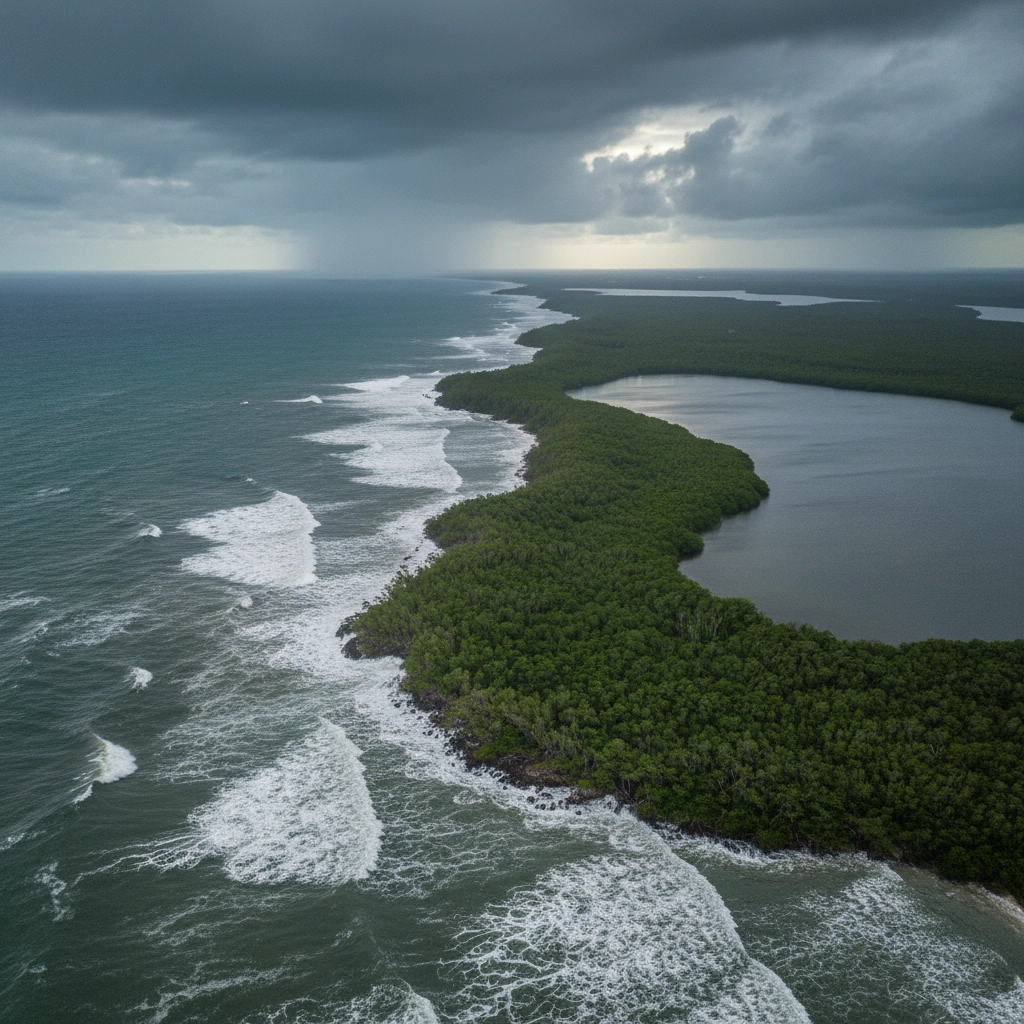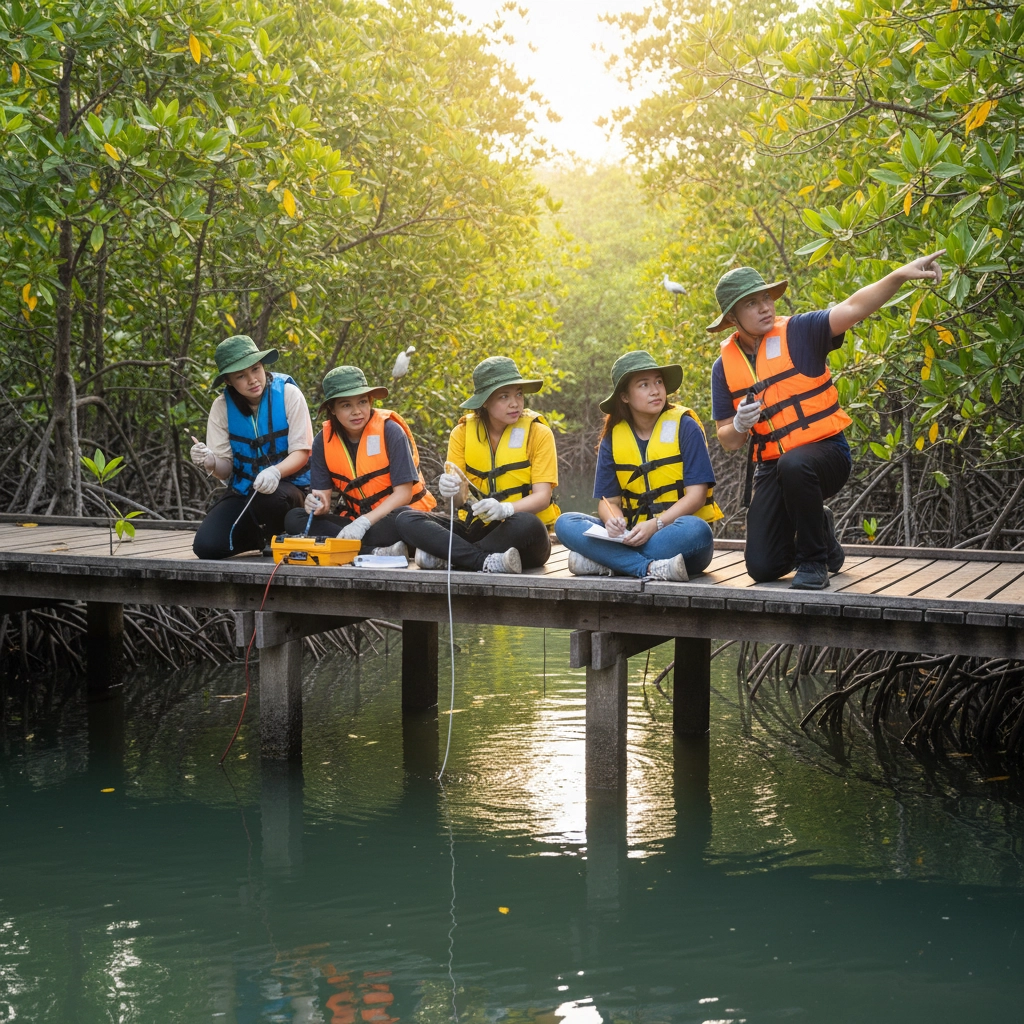Mangroves of the Florida Keys: Types and Ecological Importance
- Caleb Mullenix
- Oct 19
- 5 min read
Understanding the intricate mangrove ecosystems of the Florida Keys provides students with unparalleled opportunities to observe marine biology, earth science, and conservation principles in action. These salt-tolerant forests, spanning over 1,800 miles of Florida Keys shoreline, serve as living laboratories where students can witness firsthand the complex relationships between terrestrial and marine environments through carefully designed marine science expeditions.
Establishing a comprehensive understanding of mangrove ecology is essential for students pursuing earth science educational trips. These remarkable ecosystems demonstrate adaptation, symbiosis, and environmental resilience in ways that classroom instruction alone cannot replicate. Through hands-on learning trips, students develop critical thinking skills while observing how these coastal guardians protect shorelines, nurture marine life, and maintain water quality.
The Three Primary Mangrove Species: Nature's Coastal Engineers
The Florida Keys host three distinct mangrove species, each displaying unique adaptations that students can observe and document during field studies. Begin by teaching students to identify these species through their distinctive characteristics, root systems, and growth patterns.
Red Mangrove (Rhizophora mangle) stands as the most recognizable species, positioned along the water's edge where conditions prove harshest. Encourage students to observe the distinctive reddish prop roots extending from trunks and branches, creating the characteristic "walking on water" appearance. These aerial roots, resembling tall stilts, provide stability while delivering oxygen to underwater root systems. Students can measure and document how these trees typically reach 20 feet in Florida waters, though optimal conditions support growth exceeding 80 feet.
Direct students' attention to the remarkable reproductive strategy of red mangroves. The seeds germinate while attached to parent trees, producing distinctive 6-inch pencil-shaped propagules. Students can collect these naturally shed propagules for observation, noting how they drop as fully mature plants ready for immediate establishment. This adaptation demonstrates nature's solution to harsh saltwater conditions that would typically prevent seed survival.

Black Mangrove (Avicennia germinans) presents different adaptations for student examination. Guide students in identifying the characteristic pneumatophores: vertical aerating branches extending up to 20 centimeters above soil surfaces. These "breathing roots" provide oxygen to underground systems in oxygen-poor mud environments. Students can count and measure these structures while observing how they create distinctive patterns across mangrove floors.
Emphasize the salt-excreting adaptation visible on black mangrove leaves. Students can observe salt crystals accumulating on upper leaf surfaces, demonstrating the tree's mechanism for managing excess salinity. The dark, scaly bark and white flowers pollinated by bees provide additional identification markers students can document through field journals and photography.
White Mangrove (Laguncularia racemosa) grows in higher intertidal zones, reaching approximately 45 feet with characteristically smooth, white bark and oval-shaped leaves. Students can observe the salt-excreting glands at leaf bases while noting the more upright growth form compared to other species. When growing in oxygen-poor conditions, white mangroves develop pneumatophores, providing students opportunities to compare adaptive responses across species.
Understanding Ecological Functions Through Direct Observation
Mangrove ecosystems provide exceptional opportunities for students to observe complex ecological relationships during conservation science trips. Direct students to document the multiple ecosystem services these forests provide while emphasizing the interconnected nature of marine and terrestrial environments.
Water Filtration and Quality Maintenance becomes evident through hands-on water testing activities. Students can collect water samples from various points around mangrove systems, testing for clarity, salinity, and pollutant levels. The extensive root systems act as natural filters, demonstrating how mangroves maintain the crystal-clear water quality characteristic of the Florida Keys. Encourage students to compare water quality readings from mangrove-protected areas with samples from unprotected coastlines.
Nursery Habitat Functions provide students with opportunities to observe marine biodiversity firsthand. Guide students in identifying juvenile fish, crabs, and shellfish utilizing mangrove root systems for protection and feeding. The intricate root networks create natural shelters where young marine animals develop before venturing into open waters. Students can document species diversity while learning that 75 percent of game fish and 90 percent of commercial fish species depend on mangrove habitats during critical life stages.

Students should observe and record feeding relationships within mangrove systems. Snook, snapper, tarpon, jack, sheepshead, red drum, oysters, and shrimp all depend on mangrove environments for survival. Create opportunities for students to witness feeding behaviors and document food web relationships through systematic observation and data collection.
Educational Benefits of Mangrove Exploration
Hands-on learning trips focusing on mangrove ecosystems provide students with multidisciplinary educational experiences combining marine biology, earth science, chemistry, and environmental conservation. Structure learning activities to maximize student engagement while ensuring comprehensive understanding of ecological principles.
Adaptation and Survival Strategies become immediately apparent through direct observation. Students can examine salt-excreting mechanisms, specialized root systems, and reproductive adaptations while developing understanding of how organisms modify structure and function to survive in challenging environments. Encourage students to create detailed drawings and measurements of adaptations while hypothesizing about their functions.
Coastal Protection Mechanisms demonstrate earth science principles in action. Students can observe how mangrove root systems stabilize shorelines, absorb wave energy, and prevent erosion during storm events. Reference Hurricane Irma's impact on Long Key State Park mangroves in September 2017, where despite sustaining damage, the forests buffered storm surge impacts. Students can measure and document evidence of coastal protection while understanding the relationship between biological systems and geological processes.

Wildlife Habitat Diversity provides opportunities for comprehensive biodiversity studies. Mangrove forests support approximately 220 fish species, 24 reptile species, 18 mammal species, and 181 bird species. Students can conduct systematic wildlife surveys while learning identification techniques for wading birds, Key deer, American crocodiles, and numerous other species. Great White Herons utilizing mangroves for feeding and nesting provide exceptional observation opportunities for understanding habitat requirements.
Safety and Preparation for Mangrove Studies
Ensuring student safety during mangrove exploration requires careful planning and adherence to established safety protocols. Begin preparation well in advance of departure, emphasizing the importance of proper equipment, emergency procedures, and environmental awareness.
Environmental Hazards and Precautions must be thoroughly addressed before field activities commence. Educate students about potential encounters with marine life, including stingrays, jellyfish, and occasional crocodiles. Emphasize the importance of observing wildlife from appropriate distances while maintaining awareness of surroundings. Establish clear boundaries for exploration areas and ensure constant adult supervision during all activities.
Equipment and Clothing Requirements ensure student comfort and safety throughout extended outdoor activities. Provide students with comprehensive packing lists including closed-toe water shoes, sun protection, insect repellent, and weather-appropriate clothing. Emphasize the importance of bringing multiple water bottles and snacks to maintain energy levels during active field studies.
Emergency Procedures and Communication protocols must be established and clearly communicated to all participants. Share detailed itinerary information with parents and school administrators while maintaining updated emergency contact lists. Ensure all supervising adults understand evacuation procedures and have access to communication devices throughout activities.

Data Collection and Documentation Standards help students maintain focus while ensuring productive learning outcomes. Provide students with standardized data collection sheets, field journals, and measurement tools. Establish clear expectations for scientific observation, sketching, photography, and note-taking while emphasizing accuracy and attention to detail.
Connecting Classroom Learning to Real-World Applications
Marine science expeditions focusing on mangrove ecosystems bridge the gap between theoretical knowledge and practical understanding. Students develop deeper appreciation for environmental conservation while gaining hands-on experience with scientific methodology and data collection techniques.
Climate Change and Conservation Awareness emerges naturally through mangrove studies. Students can observe and discuss how these ecosystems store carbon, regulate coastal temperatures, and adapt to changing environmental conditions. Encourage students to consider how human activities impact mangrove health while exploring conservation strategies and restoration efforts.
Scientific Method Application occurs throughout field studies as students formulate hypotheses, collect data, and draw conclusions about mangrove adaptations and ecological functions. Provide opportunities for students to design their own investigation questions while maintaining focus on safety and environmental responsibility.
Understanding mangrove ecosystems through direct experience creates lasting educational impact that extends far beyond traditional classroom boundaries. These living laboratories demonstrate the intricate connections between marine and terrestrial environments while showcasing nature's remarkable adaptability and resilience. Students return from conservation science trips with enhanced appreciation for environmental stewardship and deeper understanding of the complex systems supporting coastal communities.
Properly planned and executed mangrove exploration provides students with transformative educational experiences that inspire lifelong interest in marine science and environmental conservation. The combination of hands-on observation, scientific methodology, and environmental awareness creates comprehensive learning opportunities that classroom instruction alone cannot replicate.



Comments